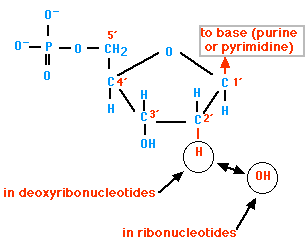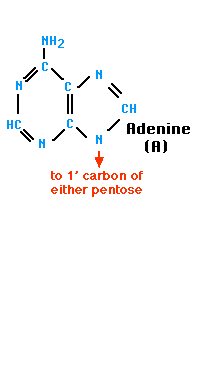
Nucleotides consist of three parts:
1. A five-carbon sugar (hence a pentose). Two kinds are found:
Deoxyribose-containing nucleotides, the deoxyribonucleotides, are the monomers of DNA.
Ribose-containing nucleotides, the ribonucleotides, are the monomers of RNA.
2. A nitrogen-containing ring structure called a base. The base is attached to the 1' carbon atom of the pentose.
In DNA, four different bases are found:RNA contains:


The combination of a base and a pentose is called a nucleoside.
3. One (as shown in the first figure), two, or three phosphate groups. These are attached to the 5' carbon atom of the pentose.
Both DNA and RNA are assembled from nucleoside triphosphates.
For DNA, these are dATP, dCTP, dGTP, and dTTP.
For RNA, these are ATP, CTP, GTP, and UTP.
In both cases, as each nucleotide is attached, the second and third phosphates are removed.
| Base | Nucleoside | Nucleotides | |||
|---|---|---|---|---|---|
| DNA | Adenine (A) | Deoxyadenosine | dAMP | dADP | dATP |
| Guanine (G) | Deoxyguanosine | dGMP | dGDP | dGTP | |
| Cytosine (C) | Deoxycytidine | dCMP | dCDP | dCTP | |
| Thymine (T) | Deoxythymidine | dTMP | dTDP | dTTP | |
| RNA | Adenine (A) | Adenosine | AMP | ADP | ATP |
| Guanine (G) | Guanosine | GMP | GDP | GTP | |
| Cytosine (C) | Cytidine | CMP | CDP | CTP | |
| Uracil (U) | Uridine | UMP | UDP | UTP | |
| Welcome&Next Search |